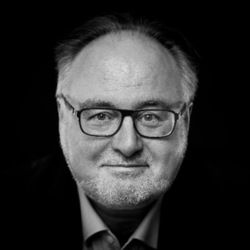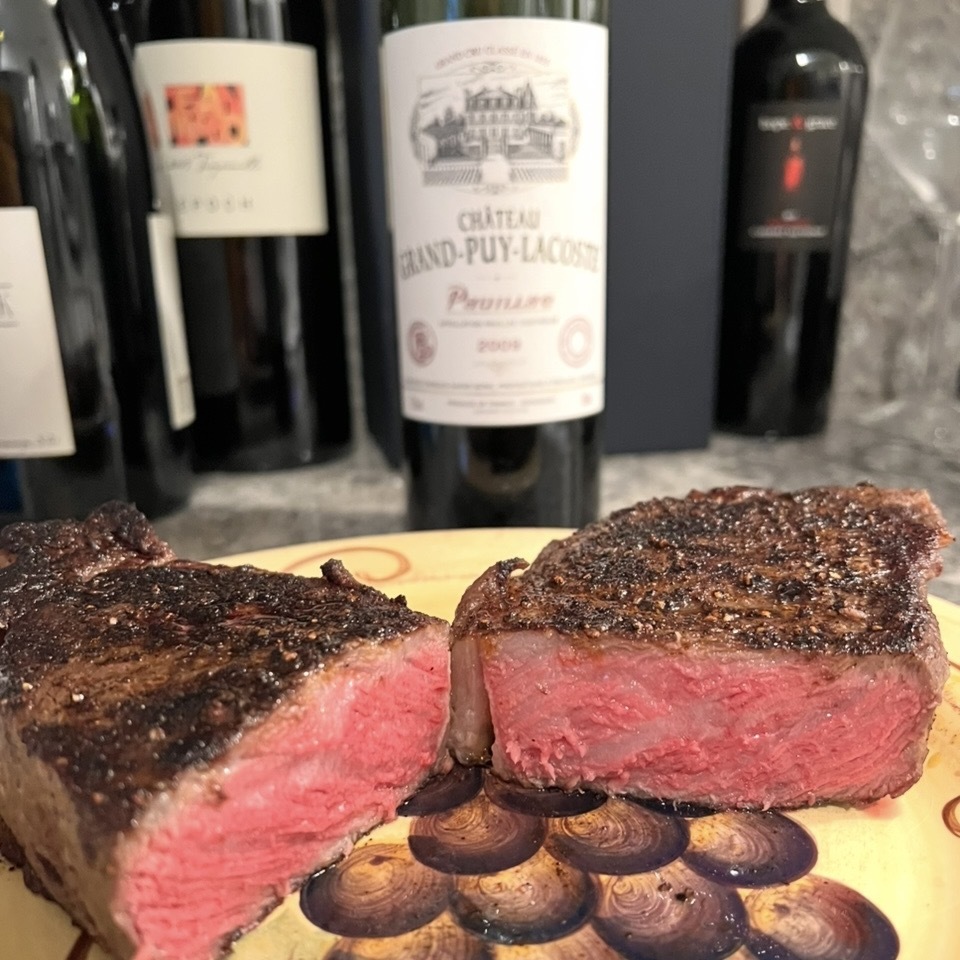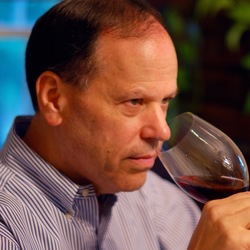Luc Marie Michel
Michel & Stéphane Ogier (d'Ampuis)
Côte-Rôtie Syrah 2018
At Table de Sorgue in Sorgue (near Avignon) on 10/1/2020 with François et Marie-José Lenhardt. — 5 years ago
Château Branaire (Duluc-Ducru)
St. Julien Red Bordeaux Blend 2006
On the nose, bright, ripe, ruby; blackberries, dark cherries, black raspberries, blue fruit mix, strawberries, creamy raspberries, plums, cranberries, black tea, loamy soils, dry clay, dry stones, limestone minerals, saddlewood, crush dry rocks, dark moist soils, dark chocolate, vanilla, field of violets, lavender and fresh red florals.
The palate is medium-full yet a little lean. The fruits are elegant, ruby, ripe; blackberries, dark cherries, black raspberries, blue fruit mix, strawberries, creamy raspberries, plums, cranberries, black tea, loamy soils, dry clay, dry stones, limestone minerals, used leather, cedar, crush dry rocks, dark moist soils, dark chocolate, vanilla, field of violets, lavender and fresh red florals. The acidity is very good. The length, balance and length are nice. The structure a little lean. It a well polished rich fruit finish, but is a little short.
Photos of; the Chateau, Owner Patrick Maroteaux (may he RIP), Estate grapes and their barrel room.
Producer notes & history...Branaire Ducru has a long history has a long history that dates back to 1680. In those days, Branaire Ducru was a part of a larger Beychevelle. When the owner of Beychevelle passed away, he left behind a huge Bordeaux vineyard that was seriously in debt. To pay off the debt, the vineyard was broken up and sold. Several new estates were created in Saint Julien, which include Chateau Branaire Ducru. Jean-Baptiste Braneyre created the estate in 1680. As was was tradition in Bordeaux, the owner gave the estate his name, which is where the first part of the properties name came was given. Braneyre was later altered to Branaire. Braneyre bought the land we know as Branaire Ducru because of the terroir. He understood that Cabernet Sauvignon grew best on the deep gravel soils found in the Medoc. With that, we have the birth of Branaire Ducru. Or, at least the Branaire part. The middle name was gained through marriage. Marie Braneyre married Pierre de Luc which as you can guess, gave us the Branaire Duluc (the name of their 2nd wine). Almost 100 years later, the first winery at the property was constructed in 1824. It took almost 200 years for the Ducru portion of the wines name to make its way to the label. In 1875, with no direct descendants, Gustave Ducru, a more distant relative took over the property and added his name to the label making it, Chateau Branaire Ducru.
Patrick Maroteaux bought Branaire Ducru in 1988 from the Tapie family who had owned It since 1919. Prior to his ownership of Branaire Ducru, Patrick Maroteaux had no prior experience in the wine business. His background was in banking and then a president of the massive sugar company, Eurosucre. Patrick Maroteaux also served as the President of the UGCB, Union of Grand Crus Bordeaux, and as the President of the Saint Julien appellation.
Since his purchase, Patrick Maroteaux has focused much of his efforts on performing extensive work in the vineyards and in the cellars. He also began reducing the yields. Additionally, he increased the size of their vineyards by 10 hectares. Patrick was also modernized their winemaking techniques.
In fact, Patrick Maroteaux was one of the first producers in the Left Bank to being filling his tanks entirely by gravity. He did this beginning with the 91 vintage. This was done with the help of Philippe Dhalluin.
Philippe Dhalluin left Branaire Ducru in 2004 and took the same position as the director for wine making at Chateau Mouton Rothschild. Philippe Dhalluin was replaced by Jean Dominique Videau.
Chateau Branaire Ducru is a family business. The son of Patrick Maroteaux, François Xavier Maroteaux has carried the family business and joined the estate. Sadly, on November 19, 2017, Patrick Maroteaux passed away at the age of 67. His son, François Xavier Maroteaux took over the full time responsibilities of managing the property.
All the new technical improvements at Branaire Ducru quickly paid off for Patrick Maroteaux. Beginning with the 2000 vintage, Branaire Ducru became one of the top Saint Julien wines. It’s also one of the better values for high quality Bordeaux.
The 60 hectare vineyard of Branaire Ducru is planted to 65% Cabernet-Sauvignon, 28% Merlot, 4% Cabernet Franc and 3% Petit Verdot. The vineyard is very close to the size it was during the time of the 1855 Classification.
The terroir is deep gravel with clay soils. The best terroir is located near the chateau, closest to the Gironde river. They also have blocks further inland, with a small section of vines placed close to Chateau Lagrange and Chateau Talbot. The vineyard can be divided into 15 different blocks with 70 different parcels of vines. On average, the vines are close to 35 years of age. However, the estate has older vines as well. The oldest vines date back close to 90 years of age. The vineyard is planted to a vine density that ranges from 6,700 to 10,000 vines per hectare. The higher levels of vine density are for the newer plantings. The goal of the property is to continue increasing the vine density in all of their better terroirs.
Branaire Ducru, fermentation takes place in 28 temperature controlled, stainless steel tanks. The 28 vats vary in size. The vats range in size from as small as 30 hectoliters and up to 210 hectoliters. Each vat is sized for the needs of each specific vineyard parcel. Each vat is filled using the gravity based system.
Branaire Ducru is aged in 60 to 65% new, French oak barrels for between 16-20 months. The amount of new oak varies depending on the quality, character and style of each vintage. On average, the annual production is about 25,000 cases depending on the vintage. — 8 years ago

Virginie de Valandraud
St. Émilion Red Bordeaux Blend 2000
A steal on auction
I wouldn’t consider it a 🥩 wine but great with charcuterie
Web info
Chateau Valandraud is represented by the passion of a couple: Jean-Luc Thunevin and Murielle Andraud. Following the great success with the wine merchant business in Saint Emilion, they opened their own vineyard to produce their own wine.
In 1989, they bought a small parcel of 0.6 hectare (1.48 acres) located in a small valley near Saint Emilion between Pavie-Macquin and La Clotte. The origin of the wine name is as much geographic (Val: Vallon de Fongaban), as sentimental (Andraud: Murielle’s maiden name). Thus Chateau Valandraud was born.
Little by little, Jean-Luc and his wife purchased several other parcels of vines, and now, the domain represents a total surface of 10 hectares (24.71 acres), located in various areas of Saint Emilion. The diversity of soils and varietals permit the production of 6 different wines: Chateau Valandraud, Chateau Valandraud Casher, Virginie de Valandraud and the 3 de Valandraud (the second wine of Chateau Valandraud and Virginie de Valandraud), Blanc de Valandraud N° 1 and N° 2.
The final blending of the various parcels occurs in the month of March, following a blind tasting with the help of the world famous oenologist, Michel Rolland. — 2 years ago
Luc-Marie Michel
Zélige Caravent Red Rhone Blend 2006
$16 right proper m8 — 8 years ago
Lucien Michel
Le Vieux Donjon Châteauneuf-du-Pape Red Rhone Blend 2010
With all due respect to Joseph Gordon-Levitt, this is the original Donjon. Claire Fabre represents the third generation in charge at Le Vieux Donjon. Founded in 1966 by her grandfather Marcel Michel, and run by her parents Lucien and Marie José Michel from 1979 to 2008. Prior to taking the reins, Claire interned with Harlan Estate in Napa. Consulting oenologist Philippe Cambie also lends his services. Despite the Harlan/Cambie associations, Le Vieux Donjon is old school, through and through, and ascribes to the traditionalist principle of "one estate, one wine." The 2010 does not disappoint. While there's clearly a smoked mesquite overtone that permeates throughout and continuously, the plum, black cherry, kirsch, black olive, lavender, dried Provençal herbs, tar, and cured meat entangle thoroughly. The result is an incense that doesn't quit. — 8 years ago
Lucien Michel
Le Vieux Donjon Châteauneuf-du-Pape Red Rhone Blend 2005
Le Vieux Donjon was created in 1979 with the marriage of Lucien and Marie José Michel. Both Lucien and Marie José's parents owned vineyards in the region, and those holding were combined to form Le Vieux Donjon. Had this tucked away in the cellar, deep Ruby with aromas of sweet black fruits and spice. Flavors of cherry and blackberry, complex notes if oak and pepper spice. Full body, well balanced with lingering finish, perfect now. Outstanding. — 9 years ago
Le Vieux Donjon
Châteauneuf-du-Pape Red Rhône Blend 2012
Le Vieux Donjon was created in 1979 with the marriage of Lucien and Marie José Michel. Both Lucien & Marie José's parents owned vineyards in the region, and those holding were combined to form Le Vieux Donjon. Medium Ruby with aromas of sweet black fruits and pepper spice. On the palate complex flavors of cherry and blackberry, with notes if oak and spice. Full body, well balanced with long finish, perfect now. Outstanding. — 5 years ago
Jean-Luc Colombo
Les Méjeans Cornas Syrah 2015
@ Michel Chabran — 6 years ago
Château Cos d'Estournel
Saint-Estèphe Red Bordeaux Blend 1991
Is there any meal better than steak (Ribeye) and well aged Claret? This is another 1991 Bordeaux experiment of mine. 1991 was a vintage with horrible frosts and a less than favorable growing season, right? A vintage critically panned. This is my 3rd recent 91 from a good producer. And again, it didn’t disappoint. Like 97 and 07, it’s better with the right bottle age than young. Magic evolution happened in the bottle way down the road. This 91 is in great form with a fair amount of life ahead of it. On the nose; a little ripe fruit funk, wonderful dark & lighter red cassis, ripe blackberries, dark cherries, poached strawberries, plums, hues of blueberries, black raspberries, dry cranberries, vanilla, light cinnamon, rich, black turned earth, cedar, soft leather, dry stones, dry top soil, notes of dry herbs and fresh & dry red flowers. The body/palate is medium, round, ripe & still fresh. The tannins nearly completely resolved. Ripe, floral fruits of; blackberries, dark cherries, poached strawberries, plums, hues of blueberries, black raspberries, dry cranberries & half cooked rhubarb. Vanilla, light cinnamon, touch of clove & nutmeg, rich, black turned earth, cedar, soft leather, dry stones, dry crushed rocks, dry top soil, notes of dry herbs, a little band-aid and fresh & dry red flowers. The acidity drips over the palate and the long, well balanced, still structured, nice tension, good length finish lasts over a minute. Again, love & appreciate the 12.5% alcohol. What a beauty with and without the steak. Next time you’re in your fine wine retail shop and see a quality producers 91 that’s been well stored, buy it and have it with a Ribeye. Photos of; their exotic Estate, Chateau interior, newer barrel room and their vines as viewed from the front of the Chateau that are across the road. Producer notes and history...Cos d’Estournel has a long distinguished history in the St. Estephe. Louis Gaspard d’Estournel, gave his name to the estate after founding in 1811. It did not take long before Cos d’Estournel became famous with wine lovers and royalty all over the world. In those early days, Cos d’Estournel did not sell through Negociants. The owner preferred selling his wine directly to his customers. In fact, Cos d’Estournel was exported to numerous countries across the globe, with a large portion of the production being sold to India. It was that connection to India that inspired much of the unique, east Indian design we see at Cos d’Estournel today. Cos d’Estournel was one of the first Bordeaux Chateaux’s to bottle, label and sell their own wine. This practice continued until the death of Louis Gaspard d’Estournel in 1852. If you’re at the property, the statue on the bench in the front courtyard is of the founder, Louis Gaspard d’Estournel. The Estate was then purchased by an owner that sold their wines on the Place de Bordeaux using the negociant system. If the Chateau was not selling their wines through the negociant system, it would never have been included in the 1855 Classification. Imagine that! So, it turned out to be a fortuitous decision. Cos d’Estournel was sold to the Charmolue family owners of the neighboring Estate of Chateau Montrose. They continued to own the estate until 1917, when it was bought by Fernand Ginestet. This purchase was the beginning of the next major step in the development of Cos d’Estournel. Decades later, the grandchildren of Fernand Ginestet, Jean-Marie Prats, Yves Prats and Bruno Prats took over ownership and management of Cos d’Estournel. In 1995, Bruno Prats sold the property to the Merlaut family, owners of the Taillan Group. The next era in the development of Cos d’Estournel took place in 2000, when Cos d’Estournel was bought by the industrious and wealthy Michel Reybier, who earned his fortune in the food industry. Michel Reybier hired the son of Bruno Prats, Jean-Guillaume Prats to manage Cos d’Estournel. Things further improved with the efforts of Jean-Guillaume Prats who helped design the most modern wine making at that time. A complete renovation of Cos d’Estournel took place in not only the wine making facilities and cellars, but in parts of the Chateau as well. While the wine making facilities are completely modern with their 100% gravity design, the outward appearance retained the original design and feeling that has always been a part of Cos d’Estournel. On October 15, 2012, Jean Guillaume Prats announced he was leaving Cos d’Estournel to join LVMH (Pichon Baron). Jean Guillaume Prats was replaced by Aymeric de Gironde. Following the departure of Aymeric de Gironde in 2017, the owner, Michel Reybier took over managing the Estate. What makes the remodel special is that the cellars of Cos d’Estournel are entirely operated by gravity. There are no pumps of any kind to force the wine. The purpose is to allow a gentleness to the wine and improve its purity and allow for the expression of their terroir. It set a new benchmark for cellars not only in the Left Bank, but in all of Bordeaux. Perhaps, the most inventive part of the cellars is the four 100 hectoliter lift tanks or wine elevators that replace the pumps used in the traditional pumping over and the racking off processes, which introduce air and often destabilize the marc. From the moment the grapes arrive, everything travels by the flow of gravity. Jean Guillaume Prats called this process a “pumpless pump over.” The 91 hectare vineyard of Cos d’Estournel is planted to 65% Cabernet Sauvignon, 33% Merlot, 1% Cabernet Franc and 1% Petit Verdot. The vineyard is located extremely close to the border between Pauillac and Saint Estephe at the southern tip of the Saint Estephe. The Estate has very old Merlot vines as well, which date back more than 100 years. Part of the terroir is situated on the hill of Cos, which is at a high elevation for the Medoc at 20 meters. They also make a second wine called Pagodes de Cos. This is a great wine to buy in very good vintages. Especially, if your budget prohibits you from purchasing their first wine. — 8 years ago











Michael Dierberg
Very elegant, subtle nose that pulls you in rather than jump out at you. Best wine in blind tasting of four including Dumol, Hubert Lamy, and Rivers-Marie. — 5 months ago